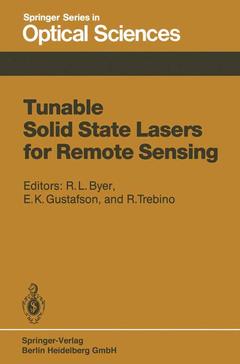Tunable Solid State Lasers for Remote Sensing, Softcover reprint of the original 1st ed. 1985 Proceedings of the NASA Conference Stanford University, Stanford, USA, October 1–3, 1984 Springer Series in Optical Sciences Series, Vol. 51
Langue : Anglais
Coordonnateurs : Byer Robert L., Gustafson Eric K., Trebino Rick

The Workshop on Tunable Solid State Lasers for Remote Sensing was held at Stanford University in October 1984 to assess the state of the art in tunable solid state lasers for remote sensing from satellite platforms. The value of conducting global remote sensing measurements of atmospheric chemistry, climate, and weather in the 1990s is now established. What is not yet defined, however, is the status of the developing tunable laser technology that must meet both the scientific requirements and the space platform constraints. This workshop was convened by the Office of Aeronautics and Space Technology (OAST) of the National Aeronautics and Space Administration (NASA) to assess the status and progress in tunable solid state laser sources for remote sensing. The workshop was organized to facilitate information exchange across a number of technologies from remote sensing requirements to crystal growth of the materials important for the development of the tunable laser sources. The emphasis was on the recent developments in tunable solid state laser sources necessary to meet the future transmitter requirements for global remote sensing. A goal of the workshop was to form recommendations to NASA on the current and future prospects for solid state laser technology that will allow remote sensing measurements from air, shuttle, and free-flying satellite platforms. The emphasis was on solid state laser sources because they offer the best potential for meeting the demanding requirements of compact size, good efficiency, and long operational lifetimes required for future space station and free-flying platform operation.
I Remote Sensing — An Overview.- NASA Plans for Spaceborne Lidar: The Earth Observing System.- Solid State Laser Technology — A NASA Perspective.- Coherent and Incoherent Lidar — an Overview.- Remote Sensing from Space Platforms.- Accommodation of a ND: YAG Lidar on a Polar Meteorological Satellite.- Solid State Bistatic Lidar for Ionospheric Species Mapping and Precise Locating Lidar for the Tethered Satellite System.- II Solid State Lasers for Remote Sensing.- Nd:YAG and Ruby Based Lidar Systems for Remote Sensing of Atmospheric Aerosols.- Remote Sensing with a Tunable Alexandrite Laser Transmitter.- Miniature Laser Diode Pumped Nd:YAG Lasers.- A Solid State Tunable Laser for Resonance Measurements of Atmospheric Sodium.- III Advances in Laser Concepts — Diode Pumped Nd:YAG.- Laser Diode Arrays for Pumping Nd:YAG.- Progress in Diode Array Development.- IV Review of Tunable Solid State Laser Systems.- Review of the Tunable Alexandrite Laser Performance.- Tunable Laser Crystal Host Systems.- Color Center Lasers: A Brief Review.- An Overview of Tunable Diode Laser Technology Development.- V The Titanium Sapphire Tunable Laser System.- An Evaluation of the Ti:Sapphire Tunable Laser System.- Flashlamp Pumped Ti:Al2O3 Laser Studies.- Preliminary Experiments on Ti:Al2O3 Laser.- Ti:Al2O3 Laser Pumped by a Frequency Doubled Nd:YAG Laser.- Absorption and Fluorescence of Alexandrite and of Titanium in Sapphire and Glass.- VI Advanced Laser Concepts — The Slab Geometry.- Progress in Solid-State Slab-Lasers.- Scalability of High Average Power Solid State Lasers.- Modeling Studies and Experimental Performance of Slab Geometry Lasers.- Slab Laser Development at MSNW: The Gemini and Centurion Systems.- VII Progress in Garnet Host Solid State Lasers.- Advanced CrystallineLaser Materials.- Use of Garnet Crystals as Laser Hosts.- Performance Study of a Cr:Nd:GSGG Laser.- VIII Growth of Lasers and Nonlinear Materials.- Growth of Codoped Garnet Crystals.- Growth of KTP.- Growth of New Laser Crystals.- Growth of Nd:YAG and Cr, Nd:GScGG. A Comparative Study.- Growth of Alexandrite and Garnet Laser Crystals.- IX Nonlinear Frequency Conversion and Tunable Sources.- Wavelength Conversion via Stimulated Raman Scattering.- Efficient Frequency Conversion of Laser Sources in Nonlinear Crystals.- Infrared Frequency Generation in Chalcopyrite Crystals AgGaS2 and AgGaGe2.- Nonlinear Optics in Single Crystal Fibers.- Laser Action of H3 Color Center in Diamond.- List of Conference Attendees.- Index of Contributors.
Date de parution : 10-2013
Ouvrage de 156 p.
15.5x23.5 cm
Thèmes de Tunable Solid State Lasers for Remote Sensing :
Mots-clés :
© 2024 LAVOISIER S.A.S.



